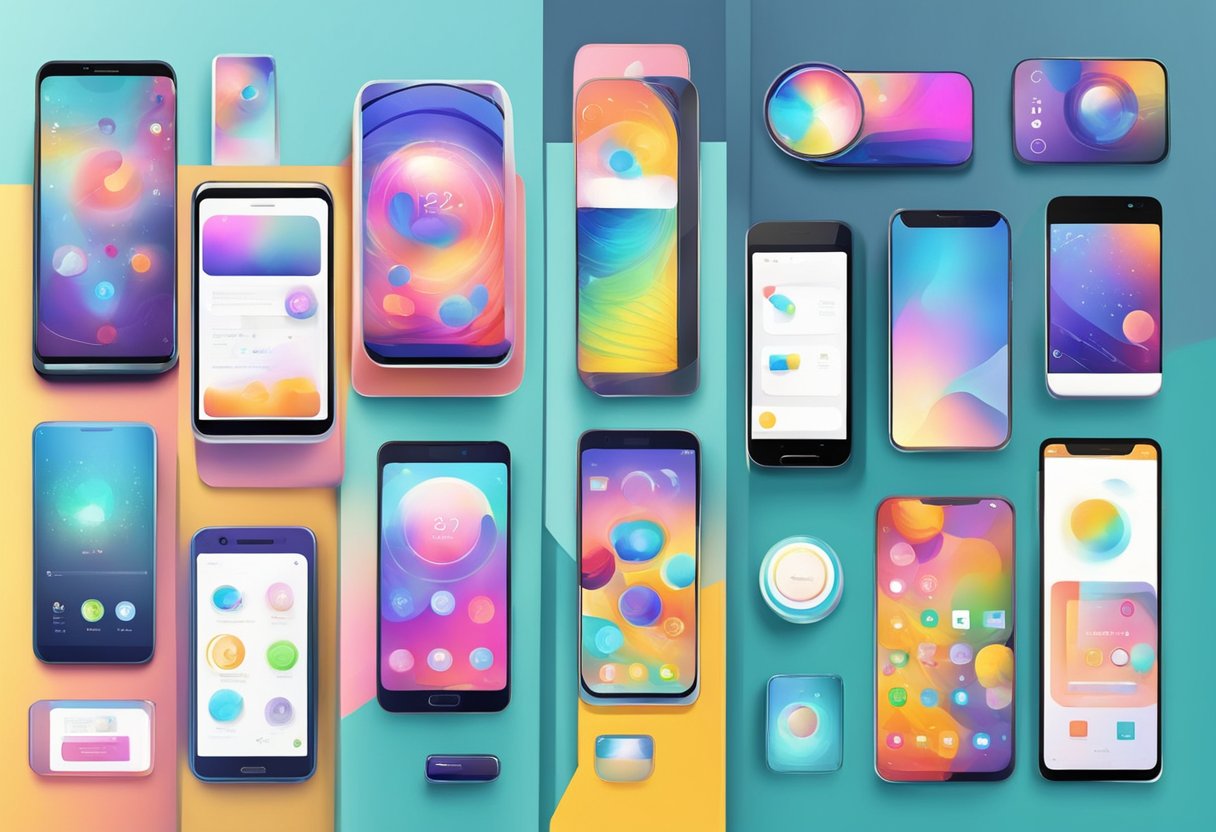Mobile phone technology is constantly evolving, with new innovations and features introduced every year. In recent years, foldable smartphones have been gaining popularity, providing users with a larger screen when unfolded while still maintaining the convenience of a compact form factor. Manufacturers such as Samsung, Huawei, and Xiaomi are leading the charge in this area, with innovative foldable designs that offer users unprecedented versatility.

Another area of innovation in mobile phone technology is haptic feedback, which provides users with tactile sensations to simulate touch. Ultrahaptics is one company that has been working on touchless haptic technology, which uses ultrasound waves to create the sensation of touch without the need for physical contact. Other companies, such as Elliptic Labs, have been developing technology that enables personal assistants like Amazon’s Echo to respond to hand gestures, providing a new way for users to interact with their devices.
In addition to these innovations, there are many other exciting developments in mobile phone technology on the horizon. From improved battery life to advanced camera features, there is no shortage of new features and capabilities that will continue to push the boundaries of what is possible with mobile devices. As technology continues to advance, it will be interesting to see what new innovations emerge and how they will shape the future of mobile phone technology.
Evolution of Mobile Phone Design
https://www.youtube.com/watch?v=xnobktms0TM&embed=true
Mobile phone design has come a long way since the first mobile phone was introduced in the 1970s. Over the years, mobile phones have evolved from being bulky and heavy to slim and lightweight. The design of mobile phones has also evolved to include various features such as touchscreens, notches, and one-handed usability.
One of the most significant changes in mobile phone design has been the move from button-based interfaces to touchscreens. Touchscreens have allowed for more intuitive and user-friendly interfaces, making it easier for users to navigate their phones. The size of mobile phone screens has also increased over the years, with many modern phones featuring screens that are over 6 inches in size.
Another design feature that has become popular in recent years is the “notch”. The notch is a cutout on the top of the phone’s display that houses the front-facing camera, sensors, and earpiece. The notch has become a popular design feature in modern smartphones, as it allows for more screen real estate without increasing the overall size of the phone.
One-handed usability has also become an important consideration in mobile phone design. With the increasing size of phone screens, it has become more difficult for users to operate their phones with one hand. To address this issue, many phone manufacturers have introduced features such as one-handed mode, which allows users to shrink the screen size for easier one-handed use.
In terms of style and appearance, mobile phones have become more sleek and stylish over the years. Many modern smartphones feature glass backs, metal frames, and other premium materials that give them a high-end look and feel. Some phone manufacturers have also introduced unique design features, such as the foldable screens found on some Samsung and Huawei phones.
Overall, mobile phone design has come a long way since the first mobile phone was introduced. With the introduction of new technologies and design features, it will be interesting to see how mobile phone design continues to evolve in the future.
Advancements in Screen and Display Technology
https://www.youtube.com/watch?v=MZrtvghyUUU&embed=true
Mobile phone screens have undergone significant advancements in recent years. The latest innovations in screen and display technology have improved the user experience by providing more vibrant and detailed visuals.
One of the most significant advancements in screen technology is the high refresh rate displays. These displays offer a smoother scrolling experience and make it easier to view fast-paced content such as videos and games. The refresh rate of a display refers to the number of times the screen updates per second, and the higher the refresh rate, the smoother the display appears. Samsung’s Galaxy S21 Ultra, for example, features a 120Hz refresh rate display, which is one of the highest in the market.
Another innovation in display technology is the introduction of foldable screens. These displays offer a larger screen size while still being portable. Samsung’s Galaxy Z Fold 3, for example, features a foldable display that can be used in a “flex mode” to split the screen into two separate displays for multitasking. This technology has the potential to revolutionize the way users interact with their devices.
Moreover, the no-notch display has been introduced to the market and has the highest screen-to-body ratio, in some phones thanks to a pop-up camera at the top of the phone. This technology allows for a more immersive viewing experience by minimizing the bezels around the screen.
In conclusion, advancements in screen and display technology have significantly improved the user experience by providing smoother scrolling, larger screens, and more immersive visuals. With the introduction of foldable screens and no-notch displays, the future of mobile phone screens looks bright.
Innovations in Camera Technology
https://www.youtube.com/watch?v=l3ujdTrbD6w&embed=true
Mobile phone cameras have come a long way since their inception. With advancements in camera technology, mobile phone cameras have become a viable alternative to traditional cameras. The latest innovations in camera technology have made it possible for mobile phone cameras to capture high-quality images and videos.
One of the most significant innovations in mobile phone camera technology is the use of multiple cameras. Many high-end smartphones now come equipped with multiple cameras, each with its own unique function. For instance, some smartphones have a wide-angle lens, while others have a telephoto lens. The use of multiple cameras has made it possible for mobile phone cameras to offer optical zoom, which was previously only possible with traditional cameras.
Another significant innovation in mobile phone camera technology is the use of computational photography. Computational photography involves using software algorithms to enhance images captured by a camera. With computational photography, mobile phone cameras can capture images with better color accuracy, improved dynamic range, and reduced noise.
The use of Time-of-Flight (ToF) sensors is another innovation in mobile phone camera technology. ToF sensors use infrared light to measure the distance between the camera and the subject. This technology makes it possible for mobile phone cameras to capture images with better depth perception, making them ideal for portrait photography.
Overall, the latest innovations in mobile phone camera technology have made it possible for mobile phone cameras to capture high-quality images and videos. With the use of multiple cameras, computational photography, and ToF sensors, mobile phone cameras have become a viable alternative to traditional cameras.
The Impact of AI and Machine Learning
https://www.youtube.com/watch?v=kmIat8UKHM8&embed=true
Artificial Intelligence (AI) and Machine Learning (ML) are revolutionizing the mobile phone industry. AI and ML are used to enhance the hardware and software of mobile phones, resulting in better user experiences.
One of the most significant impacts of AI and ML is on mobile phone cameras. AI-powered cameras can recognize and optimize settings for different scenes and objects, resulting in better image quality. Additionally, AI and ML can be used for facial recognition and augmented reality applications.
AI and ML are also used to improve battery life and performance. With AI, mobile phones can optimize power consumption by identifying and limiting energy-intensive applications. ML algorithms can also predict user behavior and adjust the phone’s performance accordingly.
Another area where AI and ML are making an impact is in personalization. Mobile phones can use AI to learn user preferences and suggest personalized content and services. For example, a phone can learn a user’s music preferences and suggest playlists or concerts in their area.
Finally, AI and ML can improve mobile security. By analyzing user behavior, AI can detect and prevent potential security threats. Additionally, facial recognition and biometric authentication can be used to provide secure access to the phone and its contents.
Overall, AI and ML are transforming the mobile phone industry, improving user experiences, and enhancing the capabilities of mobile devices.
The Role of Connectivity and Networks
https://www.youtube.com/watch?v=mo1lNRKnayA&embed=true
Connectivity and networks play a crucial role in the latest innovations in mobile phone technology. With the advent of 5G networks, mobile phones are now capable of achieving faster download and upload speeds, lower latency, and more capacity than ever before. This has opened up a whole new world of possibilities for mobile phone technology.
5G networks are expected to provide the foundation for a variety of new applications and use cases that were not possible before. For instance, 5G networks are expected to enable the development of autonomous vehicles, smart cities, remote healthcare, and much more. The high-speed connectivity provided by 5G networks will also enable seamless video streaming, online gaming, and other bandwidth-intensive applications.
In addition to 5G networks, wireless networks also play a crucial role in mobile phone technology. Wireless networks allow mobile phone users to connect to the internet and communicate with others without the need for physical cables. This has made mobile phones more portable and convenient than ever before.
Connectivity is also important for mobile phone users who need to stay connected to the internet and communicate with others while on the go. Mobile phones are now equipped with various connectivity options such as Wi-Fi, Bluetooth, and GPS. This allows users to connect to the internet and other devices, as well as navigate using GPS.
Overall, connectivity and networks are essential components of the latest innovations in mobile phone technology. With the advent of 5G networks and other wireless technologies, mobile phones are now capable of achieving faster speeds, lower latency, and more capacity than ever before. This has opened up a whole new world of possibilities for mobile phone technology, enabling the development of new applications, use cases, and much more.
Improvements in Hardware and Software
https://www.youtube.com/watch?v=gMsQO5u7-NQ&embed=true
Mobile phone technology has advanced significantly in recent years, with improvements in both hardware and software. One of the most notable hardware improvements is the increase in RAM capacity. Many high-end smartphones now come with 8GB or even 12GB of RAM, allowing for faster and smoother multitasking.
In addition to increased RAM, mobile phone hardware has also seen improvements in processing power. Many new smartphones are equipped with powerful processors that can handle even the most demanding applications with ease. This has allowed for more advanced features, such as augmented reality and machine learning, to be integrated into mobile phone software.
Speaking of software, mobile phone operating systems have also seen significant improvements in recent years. Both Android and iOS have introduced new features and improvements to their respective operating systems, such as improved notifications and better privacy controls. Additionally, many smartphone manufacturers are now offering longer software support periods, ensuring that users can continue to receive updates and security patches for several years after purchasing their device.
Another notable improvement in mobile phone software is the rise of artificial intelligence (AI) and machine learning. Many smartphone applications now use AI and machine learning algorithms to provide personalized experiences for users. For example, some camera applications use AI to automatically adjust settings based on the scene being photographed, while others use machine learning to suggest filters or effects based on previous usage patterns.
Overall, the improvements in mobile phone hardware and software have allowed for more advanced and personalized experiences for users. As technology continues to advance, it will be interesting to see what new innovations will be introduced in the world of mobile phone technology.
Security and Privacy Enhancements
https://www.youtube.com/watch?v=aMu2qpC4oQ4&embed=true
Mobile security and privacy have become increasingly important in recent years due to the rise of cyber threats and data breaches. As such, mobile phone manufacturers have been implementing various security and privacy enhancements to protect users’ data and sensitive information.
One such enhancement is continuous authentication via smartphones, which is expected to become a viable option in the coming years. This technology allows for a more secure and seamless user experience by continuously verifying the user’s identity through behavioral biometrics, such as typing speed and patterns, and facial recognition.
Another security enhancement is the implementation of zero-trust cybersecurity posture, which involves the use of digital identity to solve the identity piece at scale. This approach requires users to provide multiple forms of authentication before accessing sensitive information, adding an extra layer of security.
Mobile phone manufacturers have also been incorporating privacy-enhancing technologies into their devices. For instance, Apple’s latest iOS update includes a privacy feature that allows users to hide their IP address and location from websites they visit. This feature ensures that users’ browsing history and online activity remain private and secure.
In addition, blockchain technology has been used to improve cloud security by ensuring the confidentiality, integrity, and availability of data. This technology allows users to set the needed security levels for the system as a whole and the individual record level as needed.
Overall, mobile phone manufacturers are continuously innovating to improve the security and privacy of their devices. With the rise of cyber threats and data breaches, it is crucial for users to stay informed and take advantage of the latest security and privacy enhancements.
Notable Products and Their Unique Features

Mobile phone technology has come a long way in recent years, with manufacturers constantly pushing the boundaries of what is possible. Here are some notable products and their unique features:
Apple iPhone 14 Pro Max
The latest addition to Apple’s iPhone lineup, the iPhone 14 Pro Max is a powerhouse of a phone. It features a 6.7-inch Super Retina XDR display, A16 Bionic chip, and 5G connectivity. One of the most notable features of this phone is its camera system, which includes a triple-lens setup with 12MP ultra-wide, wide, and telephoto lenses. It also has a LiDAR scanner for improved augmented reality experiences.
Samsung Galaxy S21 Ultra
Samsung’s latest flagship phone, the Galaxy S21 Ultra, is a true powerhouse. It features a 6.8-inch Dynamic AMOLED 2X display, Exynos 2100 or Snapdragon 888 chipset, and 5G connectivity. One of the most notable features of this phone is its camera system, which includes a quad-lens setup with a 108MP primary sensor, 12MP ultra-wide lens, 10MP periscope telephoto lens, and 10MP telephoto lens. It also has a 40MP front-facing camera.
Google Pixel 6 Pro
The Google Pixel 6 Pro is the latest addition to Google’s Pixel lineup. It features a 6.7-inch OLED display, Google Tensor chip, and 5G connectivity. One of the most notable features of this phone is its camera system, which includes a dual-lens setup with a 50MP primary sensor and 12MP ultra-wide lens. It also has a 12MP front-facing camera.
Oppo Find X3 Pro
The Oppo Find X3 Pro is a flagship phone from Chinese manufacturer Oppo. It features a 6.7-inch AMOLED display, Snapdragon 888 chipset, and 5G connectivity. One of the most notable features of this phone is its camera system, which includes a quad-lens setup with a 50MP primary sensor, 50MP ultra-wide lens, 13MP telephoto lens, and 3MP microlens. It also has a 32MP front-facing camera.
Xiaomi Mi 11 Ultra
The Xiaomi Mi 11 Ultra is a flagship phone from Chinese manufacturer Xiaomi. It features a 6.81-inch AMOLED display, Snapdragon 888 chipset, and 5G connectivity. One of the most notable features of this phone is its camera system, which includes a triple-lens setup with a 50MP primary sensor, 48MP ultra-wide lens, and 48MP periscope telephoto lens. It also has a 20MP front-facing camera.
OnePlus 9 Pro
The OnePlus 9 Pro is a flagship phone from Chinese manufacturer OnePlus. It features a 6.7-inch AMOLED display, Snapdragon 888 chipset, and 5G connectivity. One of the most notable features of this phone is its camera system, which includes a quad-lens setup with a 48MP primary sensor, 50MP ultra-wide lens, 8MP telephoto lens, and 2MP monochrome lens. It also has a 16MP front-facing camera.
In conclusion, these are some of the most notable mobile phone products with unique features that are currently available in the market. Each of these phones has its own strengths and weaknesses, and it is up to the consumer to decide which one best suits their needs.
The Future of Mobile Phone Technology
https://www.youtube.com/watch?v=pbIcJHDHHns&embed=true
The mobile phone industry has come a long way since the first mobile phone was introduced in 1973. Over the years, mobile phones have transformed from basic communication devices to powerful pocket computers that can perform a wide range of functions. The future of mobile phone technology is exciting, with many potential game-changing innovations on the horizon.
One of the most significant opportunities for smartphone innovation is the integration of artificial intelligence (AI) and machine learning (ML) into mobile devices. AI and ML can help smartphones learn from user behavior, personalize experiences, and automate tasks. For example, AI can be used to optimize battery life, improve camera performance, and enhance security.
Another potential innovation in mobile phone technology is the development of foldable screens. Foldable screens can provide users with a larger display while maintaining the portability of a smartphone. This technology has already been introduced by some smartphone manufacturers, and it is expected to become more widespread in the future.
Smartphones are also expected to become more closely integrated with other devices, such as wearables and smart homes. This integration will allow users to control their homes and other devices from their smartphones, making their lives more convenient and efficient.
In conclusion, the future of mobile phone technology is full of potential and opportunities for innovation. With the integration of AI and ML, the development of foldable screens, and the closer integration of smartphones with other devices, the possibilities for smartphone innovation are endless.
Frequently Asked Questions

What are the latest features in mobile phone technology?
The latest features in mobile phone technology include foldable screens, 5G connectivity, improved cameras with higher megapixels and multiple lenses, facial recognition, augmented reality, and artificial intelligence.
What advancements can we expect in smartphone technology in the near future?
In the near future, we can expect advancements in smartphone technology such as improved battery life, faster processing speeds, more advanced AI capabilities, better security features, and more advanced biometric authentication methods.
How has mobile phone technology evolved over the years?
Mobile phone technology has evolved significantly over the years. From basic flip phones to smartphones with advanced features such as touchscreens, mobile internet, and high-quality cameras, mobile phones have become an integral part of our daily lives.
What are the unique features of the latest mobile phones?
The latest mobile phones come with unique features such as facial recognition, augmented reality, foldable screens, 5G connectivity, and advanced AI capabilities. These features provide users with a more immersive and personalized experience.
What are the current trends in mobile app development?
The current trends in mobile app development include the use of artificial intelligence, machine learning, and chatbots to create more personalized and engaging user experiences. Other trends include the use of augmented reality and virtual reality to create more immersive experiences.
What is the next big thing in mobile technology?
The next big thing in mobile technology is expected to be the development of wearable devices such as smartwatches and smart glasses. These devices will be able to interact with mobile phones and provide users with a more seamless and integrated experience. Other potential advancements include the use of biometric authentication methods and the development of more advanced AI capabilities.

